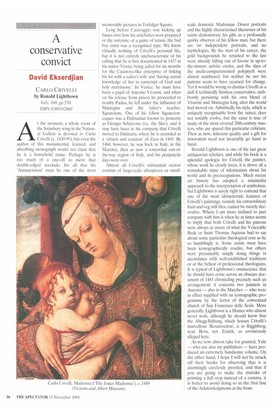A conservative convict
David Ekserdjian
CARLO CRIVELLI by Ronald Lightbown Yale, .f.60, pp.558, ISBN 0300102860 At the moment, a whole room of the Sainsbury wing in the National Gallen/ is devoted to Carlo Crivelli (c. 1430-95), but even the author of this monumental, learned, and absorbing monograph would not claim that he is a household name. Perhaps he is too much of a one-off to merit that double-edged accolade, for all that his 'Annunciation' must be one of the most
memorable pictures in Trafalgar Square.
Long before Caravaggio was kicking up fusses over how his artichokes were prepared or the outcome of a game of tennis, the bad boy artist was a recognised type. We know virtually nothing of Crivelli's personal life, but it is not entirely uncharacteristic of his calling that he is first documented in 1457 in his native Venice being jailed for six months for the Casanova-like enterprise of linking his lot with a sailor's wife and 'having carnal knowledge of her in contempt of God and holy matrimony'. In Venice, he must have been a pupil of Antonio Vivarini, and when on his release from prison he proceeded to nearby Padua, he fell under the influence of Mantegna and the latter's teacher, Squarcione. One of his fellow Squarcionesques was a Dalmatian known to posterity as Giorgio Schiavone (i.e. the Slav), and it may have been in his company that Crivelli moved to Dalmatia, where he is recorded as a 'citizen and resident' of Zara in 1465. By 1468, however, he was back in Italy, in the Marches, then as now a somewhat out-ofthe-way region of Italy, and his peripatetic days were over.
Almost all Crivelli's substantial oeuvre consists of large-scale altarpieces or small
scale domestic Madonnas. Donor portraits and the highly characterised likenesses of his saints demonstrate his gifts as a profoundly quirky observer of his fellow man, but there are no independent portraits, and no mythologies. By the start of his career, the gold backgrounds he retained to the last were already falling out of favour in up-tothe-minute artistic circles, and the days of the multi-compartmented polyptych were almost numbered, but neither he nor his patrons seem to have yearned for change. Yet it would be wrong to dismiss Crivelli as a dull if technically flawless conservative, stubbornly persisting with his own blend of Vivarini and Mantegna long after the world had moved on. Admittedly his style, which is uniquely recognisable from the outset, does not notably evolve, but the same is true of many of the most revered 20th-century masters, who are spared this particular criticism. Then as now, inherent quality and a gift for innovation need not invariably go hand in hand.
Ronald Lightbown is one of the last great antiquarian scholars, and while his book is a splendid apologia for Crivelli the painter, whose work he clearly loves, it is above all a remarkable mine of information about his world and its preoccupations. Much recent art history has adopted a minimalist approach to the interpretation of symbolism, but Lightbown is surely right to contend that one of the most idiosyncratic features of Crivelli's paintings, namely his extraordinary fruit-and-veg still lifes, cannot be merely decorative. Where I am more inclined to part company with him is when he at times seems to imply that both Crivelli and his patrons were always as aware of what the Venerable Bede or Saint Thomas Aquinas had to say about some particular theological crux as he so humblingly is. Some artists must have been iconographically erudite, but others were presumably simply doing things in accordance with well-established traditions or at the behest of professional theologians. It is typical of Lightbown's omniscience that he should have come across an obscure document of 1441 chronicling precisely such an arrangement: it concerns two painters in Ancona — also in the Marches — who were in effect supplied with an iconographic programme by the lector of the conventual church of San Francesco delle Scale. More generally, Lightbown is a Homer who almost never nods, although he should know that the Abegg-Stiftung, which houses Crivelli's marvellous 'Resurrection', is in Riggisberg, near Bern, not Zurich, as erroneously alleged here.
As we now almost take for granted, Yale — who are also my publishers — have produced an extremely handsome volume. On the other hand, I hope I will not be struck off their books for observing that it is alarmingly carelessly proofed, and that if you are going to make the mistake of printing a full stop instead of a comma, it is better to avoid doing so in the first line of the Acknowledgments at the front.


























































































 Previous page
Previous page